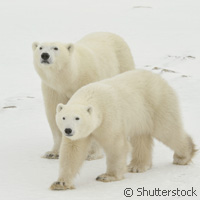Polar bears discover their Irish roots
An international team of EU-funded researchers has discovered that if the polar bear could trace its family tree it would lead back to a female brown bear that lived close to what we know today as modern Ireland, around 20,000 to 50,000 years ago in the middle of the last ice age. With a funding boost from the European Research Council as part of the Seventh Framework Programme (FP7), the team of scientists from Ireland, Russia, Spain, Sweden, the United Kingdom and the United States explains how climate changes affecting the North Atlantic ice sheet more than likely caused periodic overlaps in bear habitats. These overlaps then led to interbreeding and therefore the maternal DNA from brown bears was introduced into polar bears. During the study the team analysed 242 brown bear and polar bear mitochondrial lineages sampled over the last 120,000 years across multiple geographic ranges. Presenting their findings in the journal Current Biology, the team states that now more is known about the genealogy of polar bears, an endangered species, conservation efforts can be better targeted. There are huge differences between polar and brown bears, most notably in terms of body size, skin and coat colour, fur type, tooth structure and many other physical features. And the differences extend to their behaviour too. While polar bears are expert swimmers who are able to cope with the arctic lifestyle, brown bears are much more acclimatised to the mountainous regions, forests and valleys of Asia, Europe and North America. 'Despite these differences, we know that the two species have interbred opportunistically and probably on many occasions during the last 100,000 years,' explains Beth Shapiro, one of the researchers on the project from Pennsylvania State University in the United States. 'Most importantly, previous research has indicated that the brown bear contributed genetic material to the polar bear's mitochondrial lineage - the maternal part of the genome, or the DNA that is passed exclusively from mothers to offspring. But, until now, it was unclear just when modern polar bears acquired their mitochondrial genome in its present form.' Although scientists previously thought that the ancient female ancestor of modern polar bears lived on the ABC Islands (the Alaskan islands of Admiralty, Baranof and Chichagof) around 14,000 years ago, this research moves forward our knowledge and reveals that the two species interbred much earlier. This means that the modern polar bear's mitochondrial DNA probably underwent fixation - a drastic reduction in genetic variation and transition to a state in which the entire gene pool includes only one form of a particular gene. Although both polar bears and brown bears have experienced long periods of geographic stability, episodes of both warming and cooling during the last 500,000 years or more likely led to environmental conditions favourable to interbreeding between the two bear species. 'Polar and brown bears likely came into contact intermittently, in particular in coastal regions where the effects of climate change may have been more pronounced,' Shapiro says. 'Whenever they come into contact, there seems to be little barrier to their mating. The bottom line is that the two species bumped up against one another for extended periods of time on different occasions, sharing both habitats and genes.' The climate changes that meant the two bears could meet included vast fluctuations in the amount and distribution of habitats in the North Atlantic region. These fluctuations would have caused the geographic ranges of polar and brown bears to overlap temporarily. For example, during a warming period elevated air temperatures, melting glacial ice and rising sea levels likely forced polar bears to spend more time searching for food onshore where they would be closer to their brown bear counterparts. Equally, during a cooling glacial period brown bears living farther from the coast may have been forced into habitat normally occupied by polar bears. Around 20,000 years ago major tidewater glaciers on the western shelf and down into the Irish Sea Basin into the Celtic Sea made parts of Ireland uninhabitable due to glaciations. This means that brown bears were likely forced to spend more time on the ice shelves and on land at lower sea levels. Scientist believe the planet is now experiencing another warming period known as the Holocene or the Present Interglacial, which is even warmer than the period that marked the beginning of the last ice age. 'Interestingly, today we are seeing a similar change in the arctic climate, with melting glacial ice, fewer sea-ice days, longer open-water periods during summer, and rising sea levels,' Shapiro comments. 'And once again that change is providing polar and brown bears the opportunity to share habitats and to hybridize (interbreed). In fact, several adult hybrid bears have been reported in the last five years.' This means that conservation efforts must now also focus on hybrids.For more information, please visit:Trinity College Dublin:http://www.tcd.ie/
Countries
Ireland



